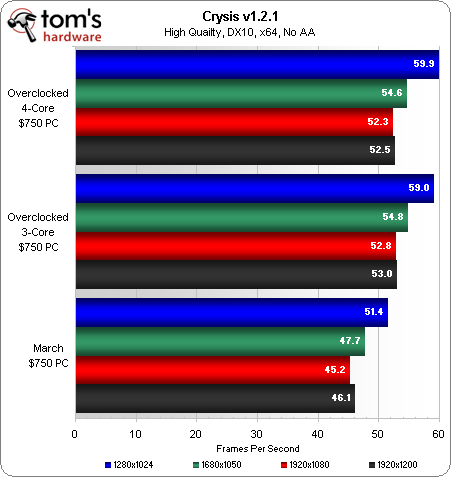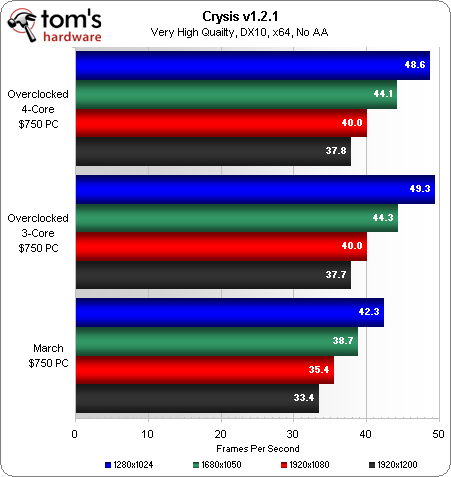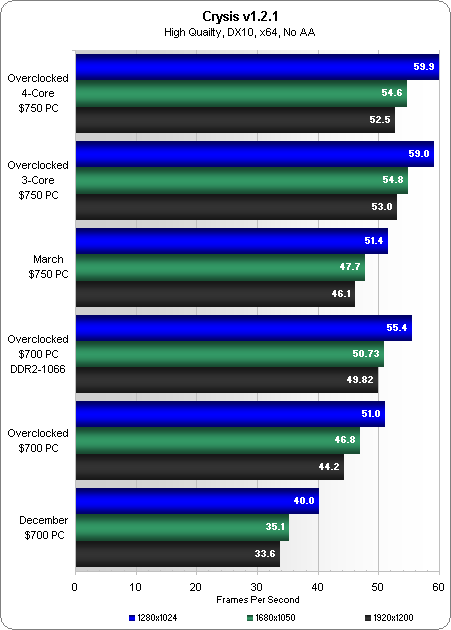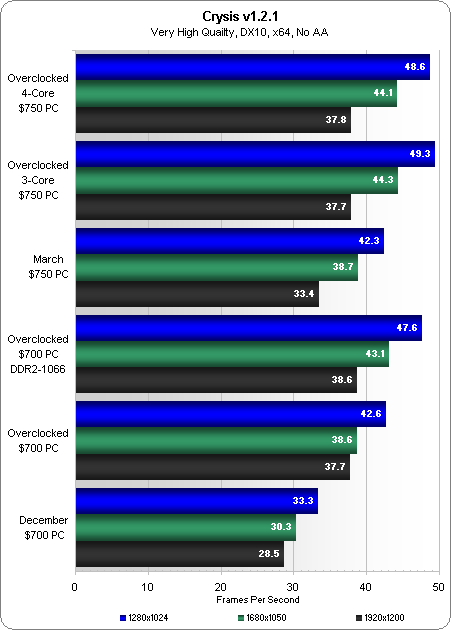System Builder Marathon, March 2010: $750 Gaming PC
Benchmark Results: Crysis
Being the only game carried over to the 2010 test suite, Crysis will give us the opportunity for comparison to the $700 SBM PC from December 2009. We include 1920x1200 data for this game, but from here on out we switch to the far more affordable 1080p resolution.
The stock $750 PC delivers playable performance at high details through all the tested resolutions, and picks up an additional 15% increase from overclocking. The unlocked processor core makes very little difference here in this game. You may also notice at these settings that the switch to a resolution of 1920x1080 results in the slightest performance drop.
The added demands of very high details limit the stock $750 PC to lower resolutions, but our overclocking efforts reward us with a fair level of playability all the way up through 1080p. The fourth core provides no benefit, and in each case performance drops off a bit at 1920x1200.
After seeing a fairly impressive showing by this month’s $750 gaming PC, let’s add data from the last SBM to see how the two systems compare. To note, the latest Catalyst 9.11 display drivers were used back in December and Catalyst 10.2 was used for the March system.
As mentioned in the conclusion of the previous article, we re-ran tests with a memory swap and found the non-tweaked basic DDR2-800 RAM was limiting gaming performance between 6%-14%. Here we’ll include that extra data series from pairing CL5 DDR2-1066 with our overclocked December system.
It’s no surprise that this month’s $750 PC offers the better stock performance, although the margin is larger than we may have expected. What’s most interesting is at these detail levels, the stock $750 PC even outperforms last month's overclocked PC. Increasing memory bandwidth with faster RAM brought in an extra four to five frames per second (FPS), but still wasn’t enough to catch up to current overclocked AMD machine.
Crysis at very high details will give us a good look at whether the pair of Radeon HD 4870s can propel the December PC into the lead and the short answer is that it does not.
The overclocked $700 PC only manages to beat the stock $750 PC at 1920x1200. In fact, the only test in which the December PC outright tops this chart comes at 1920x1200 with DDR2-1066 added. Performance is awfully close, but considering that these small victories come with frame rates we would call borderline-playable anyway, it’s pretty clear the real winner in Crysis is the more balanced $750 Athlon II-based PC.
Current page: Benchmark Results: Crysis
Prev Page Benchmark Results: Synthetics Next Page Benchmark Results: Call Of Duty: MW2, S.T.A.L.K.E.R.: Call of Pripyat, And DiRT 2Get Tom's Hardware's best news and in-depth reviews, straight to your inbox.
-
erdinger Good job. I Really like the system and I agree in nearly every decision.Reply
unlocking the forth core and still overclocking to 3.6Ghz is just great! I'm getting jealous because my 4th core is broken.
I'm looking forward to the value comparison. -
cruiseoveride This is almost identical to my build. But I used 2nd hand parts, dual HD4870s and it worked out just less than $600.Reply
4 cores, 3.2Ghz, 13,000 3dmark points.
Great bang-for-buck system. -
stray_gator Apart from a SBM entry, this article also provides reality check regarding the benefits of a fourth core. quite useful.Reply -
jsowoc I find the value comparisons are usually (always?) that the least expensive computer has the most "value", followed closely by the middle computer, trailed by the most expensive setup.Reply
Would it be possible to make a 3-way comparison of systems at the same price (for example, $1000)? One could be an AMD-based system, another an Intel-based, and a third maybe a graphics-heavy monster, or a MicroATX system (to see how much performance you sacrifice to stay in $1000 and fit a small form factor). -
Otus What would by interesting is a round of "upgrade" builds. Set specific budgets for ungrades and add them on top of the hardware from a previous round. That would allow commentary on upgrade paths and also help builders of new rigs.Reply -
Crashman jsowocI find the value comparisons are usually (always?) that the least expensive computer has the most "value", followed closely by the middle computer, trailed by the most expensive setup.Would it be possible to make a 3-way comparison of systems at the same price (for example, $1000)? One could be an AMD-based system, another an Intel-based, and a third maybe a graphics-heavy monster, or a MicroATX system (to see how much performance you sacrifice to stay in $1000 and fit a small form factor).Reply
Except for the CPU cooler, you usually sacrifice nothing to go Micro ATX. Tom's Hardware even did a micro-ATX SBM...where the Core i7 system sucked because it had to use the stock cooler. You can find semi-small micro-ATX cases that fit mid-sized coolers.
Antec also makes a MICRO ATX MID TOWER which REALLY sux since it misses the point of Micro ATX completely, so I don't want to hear about that one.
And of course there's Micro ATX mini-towers with the same layout as full-ATX. You get all the performance of ATX and the big cooler, with a case that's around 14-15" tall. -
jsowoc CrashmanExcept for the CPU cooler, you usually sacrifice nothing to go Micro ATX. Tom's Hardware even did a micro-ATX SBM...where the Core i7 system sucked because it had to use the stock cooler. (...)Reply
My argument was not that they should do a $500-$1000-$2000 comparison of uATX builds - they did this. I was suggesting doing a $1000intel - $1000amd - $1000uATX comparison. -
tigerwraith I still dont understand why they went with 2 gfx cards. Ive seen in a lot of reviews that even the newest games dont always work right off the bat when using Crossfire or SLi, So why not spend the money on a 5770 for this. You get DX 11, Dual to Triple moniters, and passthrough. So say you wanted to build a budget HTPC that could game Id have went with the 5770 or 5830 not only would that be a great cpu to watch on a HDTV but you would only need the HDMI cable to run everything.Reply




